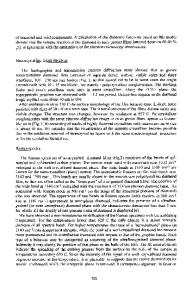Optical properties of chemical-vapor-deposited diamond films
- PDF / 873,323 Bytes
- 7 Pages / 593.28 x 841.68 pts Page_size
- 94 Downloads / 361 Views
T. A. Perry and C. P. Beetz, Jr.a) Physics Department, General Motors Research Laboratory, Warren, Michigan 48090-9055 (Received 20 September 1989; accepted 8 December 1989) Results of room-temperature optical studies on —10 micron thick, free-standing diamond films are reported. The films were grown on Si(100) substrates by hot filament-assisted chemical vapor deposition (CVD) from a methane/hydrogen mixture. The as-grown, free surface of the films exhibited a surface roughness of scale a — 0.2 to 5 microns, depending on the methane/hydrogen mixture, which introduces significant optical scattering loss for frequencies greater than 0.5 eV. Specular reflection and transmission spectra in the range 0.01-10 eV were collected. Below the threshold for interband adsorption near ~5 eV, the films studied behaved approximately as thin parallel plates of refractive index 2.4, with the rough free surface leading to increasingly larger loss of specular transmission/reflection with decreasing wavelength. Structure in the mid-infrared transmission spectra was observed and attributed to disorder-induced one-phonon absorption, intrinsic multi-phonon absorption, and infrared active -C-H 2 stretching modes. The strength of the C-H band was observed to increase with increasing methane pressure in the growth chamber. At 5.3 eV, the onset of interband absorption was observed, in good agreement with the value of the indirect bandgap in type Ha (intrinsic) diamond. I. INTRODUCTION
Crystalline diamond exhibits an unusual combination of material properties, such as extreme hardness, chemical stability, high thermal conductivity, and excellent optical transmission from the far infrared to the ultraviolet regions of the electromagnetic spectrum.1 This combination of properties makes diamond an ideal material for many potential applications ranging from wear coatings and protective optical coatings to electronic devices, both active and passive. For these reasons considerable interest exists in understanding the effects of various experimental conditions necessary for the deposition of intrinsic and doped diamond films. In this paper we report the results of optical studies on free-standing diamond films grown on Si (100) substrates by hot filament-assisted Chemical Vapor Deposition (CVD) in a dilute methane/hydrogen mixture2"5 (see Refs. 4 and 5 for a general review). The present optical study covers the range from 0.01-10 eV, and explores the effect of the partial pressures of methane and hydrogen in the growth chamber on the optical properties of CVD films. II. EXPERIMENTAL
The diamond films investigated in this research were grown at reduced pressure (~7 Torr) from dilute "'Current address: Advanced Technology Materials, Inc., New Milford, Connecticut 06776. J. Mater. Res., Vol. 5, No. 4, Apr 1990
http://journals.cambridge.org
Downloaded: 04 Apr 2015
mixtures of methane in hydrogen using hot filamentassisted CVD. Substrate temperatures were in the range 700-800 °C. The films were grown on a 2-inch diameter Si (100) wafer polished wit
Data Loading...










